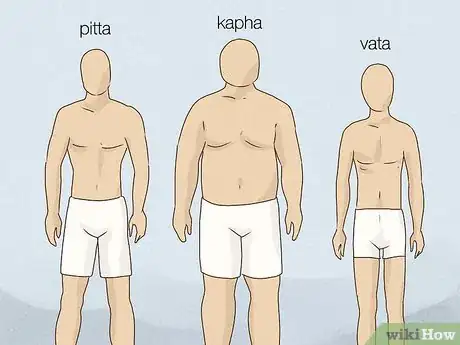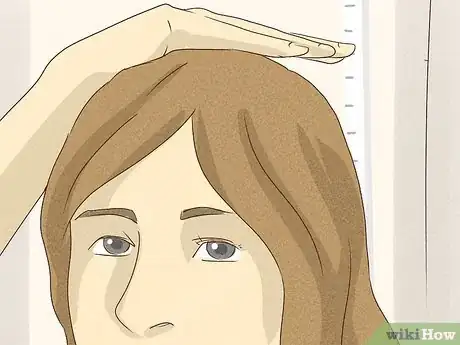This article was co-authored by wikiHow staff writer, Danielle Blinka, MA, MPA. Danielle Blinka is a Writer, Editor, Podcaster, Improv Performer, and Artist currently living in Houston, TX. She also has experience teaching English and writing to others. Danielle holds a Bachelor of Arts in English, Bachelor of Arts in Political Science, Master of Arts in English with a concentration in writing, and Master of Public Administration from Lamar University.
This article has been viewed 8,181 times.
Learn more...
You may be interested in using the ancient Indian practice of Ayurveda to help you live a healthier, happier life. If so, you probably want to know what your dosha is. According to Ayurveda, there are 3 doshas called vata, pitta, and kapha, and each dosha represents a specific blend of mental, physical, and emotional qualities. Many people have 1 dominant dosha, but you can also be a balance of 2 doshas.
Steps
Using a Tool to Find Your Dosha
-
1Take a free online quiz to quickly identify your predominant dosha. You can find many dosha quizzes online, and they’re an easy way to find your dosha. Answer the questions to the best of your knowledge to get matched with a dosha. You might even try a few of these quizzes to see if you get different results.[1]
- You can find a quiz here: https://www.yogajournal.com/lifestyle/whats-dosha
-
2Complete a dosha checklist for an in-depth body and mind evaluation. Most quizzes ask broad questions, and you may prefer to focus on the details to get your best dosha match. If so, use a checklist that breaks down each of your physical features and mental qualities. Do your best to fill out the checklist accurately so you can find the right dosha for you.[2]
- You might use this checklist: https://www.ayurveda.com/pdf/constitution.pdf
Advertisement -
3Use an Ayurveda app if you also want tips for your dosha. You might prefer to use an app if you're hoping to incorporate Ayurveda into your lifestyle. Most Ayurveda apps will help you identify your dosha. Based on your results, the app will offer you diet and lifestyle tips for balancing your dosha. Once you download an app, follow the prompts to find your dosha.[3]
- Prices for Ayurveda apps range from $1.99 to $4.99. You can find them in the app store.
-
4Work with an Ayurvedic practitioner for tailored advice. Sometimes finding your dosha can feel tricky. If you want to try Ayurvedic treatments for your dosha, you might prefer to work with a professional. Visit an Ayurvedic practitioner and let them evaluate your dosha. Then, ask them what types of treatments you might use to keep your dosha in balance.[4]
- You may be able to find an Ayurvedic practitioner online. Before you go, ask them for their credentials, including their educational background and any certifications they have. Additionally, check their client reviews and call the Better Business Bureau to see if they have any complaints.
-
5Interpret your results so you can balance your dosha. Everyone is different, so you'll likely have a blend of traits from each dosha. To find your predominant dosha, go through your responses to see which dosha you match most closely. You may discover that you have a dual dosha if you identify closely with 2 doshas. Additionally, it's possible to have a different dosha for your body and mind. Once you find your predominant dosha, you can adopt a diet and lifestyle that will help you keep it balanced.[5]
- For instance, each dosha has different dietary needs to stay balanced.
- Similarly, lifestyle changes may help keep your dosha balanced. As an example, vatas and pittas may need calming environments, while kaphas may need stimulation.
Finding Your Body Dosha
-
1Look at your body size to see if it’s small, medium, or full. According to Ayurveda, each dosha is associated with a different body type, all of which are beautiful. Examine your body frame and the shape of your figure to help you decide which dosha fits you best. Here’s the traditional break down of the doshas:[6]
- You might be vata if you consider yourself small.
- You’re probably pitta if your body is best described as average.
- If you have a fuller figure or heavier frame, you may be a kapha.
Tip: Don’t decide your dosha based on just 1 factor. Your correct dosha is the one you most identify with overall.
-
2Measure your height to see if you’re tall, medium, or short. Like with your body type, your height is also important for figuring out your dosha. Consider how your height compares to other people your age. Additionally, notice if people usually comment that you’re tall or short. Here’s what this might mean for your dosha:[7]
- Vatas are usually tall, but can also be shorter than average.
- Pittas typically have a medium height.
- If you’re shorter and tend to put on weight more easily, you’re likely a kapha.
-
3Notice if your skin tends to be dry or oily. Dry skin tends to be itchy and scaly, while oily skin is often moist but could be acne-prone. If you have dry skin, you may have more vata energy. On the other hand, pittas often have oily, acne prone skin. You may be a kapha if your skin is oily, but also soft and clear.[8]
- If you have an imbalance, you may notice skin changes, such as acne when you normally have clear skin. When you’re trying to figure out your dosha, think about how your skin is most of the time.
-
4Check if your skin feels thin and cool, warm, or thick and cool. It may be easier to ask someone else how your skin feels. Similarly, consider if people usually tell you that your touch feels hot or cold. Generally, vatas have thin, cool skin, while pittas have warm skin. If you’re a kapha, your skin may feel thick and cool.[9]
- Ask someone you trust to give you their honest opinion about how your skin feels. Say, “I’m trying to figure out if my skin feels cool or hot. What do you think?”
-
5Examine your facial features to find their shape and fullness. Everyone’s face is unique and beautiful in it’s own way, but each dosha is associated with certain facial features. Look at your eyes, nose, mouth, and face shape in a mirror or photo of yourself. Describe each of your features, then see how they match up to the different doshas.[10]
- If you’re vata, you may notice that your face is long or angular, your cheeks dip in, and your eyes are small and setback.
- If you’re pitta, you might notice a tapered face shape, smooth cheeks, bright eyes, and a long nose.
- If you’re kapha, you may have a rounded face, large eyes, and a button nose.
-
6Notice if your energy levels fluctuate or if you’re very energetic. You may notice that some people in your life have boundless energy, while others are fairly calm. According to Ayurveda, this has to do with what dosha each person is. Track your energy levels over the course of a few days, or think back to how people typically describe you. Here’s what that might mean for your dosha:[11]
- You may be vata if your energy fluctuates and comes in waves. For instance, you might be very hyper for a few hours and then super tired.
- Pittas usually have high energy. You may notice that you’re always on the go and rarely feel tired.
- Kaphas are steady but also very chill. You might have great stamina as you go through the day but may also require a lot of rest.
-
7Check your eating and digestion habits. You probably have at least one friend who always has a different appetite from you, even if you’ve both gone just as long without eating. If you follow Ayurveda, you’d probably assume that you and your friend have a different dosha. Each of the 3 doshas is associated with a different type of appetite and varied digestive problems. They go as follows:[12]
- If you have a weak appetite and occasional digestive problems, you might be vata.
- You could be pitta if you have a big appetite and good digestion.
- You might be kapha if your appetite and digestion are weak. You may even feel heavy after meals.
-
8Decide if you prefer warm, cool, or hot weather. If you’ve ever fought with someone over a thermostat setting, you know that different people can disagree on what’s hot versus what’s cold. Perhaps that’s because they have a different dosha. In general, vatas and kaphas typically run cold, while pittas are often hot. As a result, you’ll probably notice the following:[13]
- Vatas like to be in a warm, moist weather.
- Pittas are already hot, so they prefer cool weather.
- Kaphas like to heat up in hot, dry weather.
Recognizing Your Mind Dosha
-
1Decide if you’re creative, logical, or focused on helping others. Everyone has a blend of talents, so you’ll likely notice a bit of each of these types of thinking in yourself. According to Ayurveda, however, it’s likely that you have one dominant way of thinking that depends on your dosha. Here’s how that typically breaks down:[14]
- Vatas are usually very creative and imaginative.
- Pittas are often logical and focused on solutions.
- Kaphas are kind-hearted and think about what’s best for others.
-
2Notice if your speech is rapid, firm, or slow. In Ayurvedic tradition, how you speak can give you insight into your mind. Record yourself speaking so you can evaluate how fast you talk, or ask people who care about you to give you honest feedback about your speaking patterns.[15]
- You might be vata if you talk really fast and rarely stop to think over what you want to say.
- If you are very sure of your words, you’re likely pitta.
- If your speech is slow and thoughtful, you may be kapha.
-
3Check the quality of your memory. No one has a perfect memory, and you likely remember some things better than others. According to Ayurveda, how well you remember things might help you figure out which dosha you are. Consider if you have a stronger long-term memory or a better short-term memory.[16]
- As a vata, you might have a great short time memory but a poor long-term memory.
- A pitta typically has a good overall memory.
- If you’re a kapha, you might have trouble retaining information at first, but your long-term memory is probably really good.
-
4Determine if you’re more of a leader or a follower. You may have times when you want to lead and times when you want to follow, and that’s totally normal. Focus on which you like to do more to help you figure out your dosha. Here’s what your leadership preferences might mean:[17]
- Vatas usually prefer to work alone but may occasionally take the lead for a short time.
- Pittas prefer to be in charge and are often great leaders.
- Kaphas prefer to be followers and are easy to get along with.
-
5Decide if you like to follow a routine or play things by ear. While some people swear a routine keeps them on track, others feel bored when every day is the same. According to Ayurveda, this is because different doshas have different preferences when it comes to scheduling. As you go about your day, notice if you tend to follow a routine or if you like to just see what happens.[18]
- Vatas don’t like to follow a routine and may have a chaotic schedule.
- Pittas might follow a routine but can be flexible if necessary.
- Kaphas prefer a routine and will resist changing it.
-
6Track your sleep habits to help figure out your dosha. Some people fall asleep as soon as their head hits the pillow, while others toss and turn before finally falling asleep. Knowing which group you fall into might help you figure out your dosha. For a week, keep track of how long it takes you to fall asleep and how many hours of sleep you get to help you narrow down your dosha.[19]
- Vatas often have trouble sleeping.
- Pittas may get less sleep but feel restored afterward.
- Kaphas typically sleep soundly.
References
- ↑ https://www.yogajournal.com/lifestyle/whats-dosha
- ↑ https://www.ayurveda.com/pdf/constitution.pdf
- ↑ https://basmati.com/2017/08/18/top-5-ayurveda-apps
- ↑ http://www.eattasteheal.com/Ayurveda101/ETH_BodyTypes.htm
- ↑ http://www.eattasteheal.com/Ayurveda101/ETH_BodyTypes.htm
- ↑ http://www.eattasteheal.com/ETH_dosha.htm
- ↑ https://www.ayurveda.com/pdf/constitution.pdf
- ↑ http://www.eattasteheal.com/ETH_dosha.htm
- ↑ https://www.ayurveda.com/pdf/constitution.pdf
- ↑ https://www.ayurveda.com/pdf/constitution.pdf
- ↑ http://www.eattasteheal.com/ETH_dosha.htm
- ↑ http://www.eattasteheal.com/ETH_dosha.htm
- ↑ http://www.eattasteheal.com/ETH_dosha.htm
- ↑ http://www.eattasteheal.com/ETH_dosha.htm
- ↑ https://www.ayurveda.com/pdf/constitution.pdf
- ↑ https://www.ayurveda.com/pdf/constitution.pdf
- ↑ http://www.eattasteheal.com/ETH_dosha.htm
- ↑ http://www.eattasteheal.com/ETH_dosha.htm
- ↑ https://www.ayurveda.com/pdf/constitution.pdf
- ↑ https://www.ayurveda.com/pdf/constitution.pdf














































































